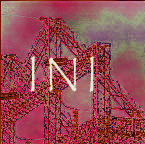|
|  |
| ADIEU, 1996 |

|
| KIKI FRANCHESCI |
MARYCLAIRE WELLINGER Poet & Painter
M-C is a member of INISMO, an Italian Avant garde movement in the ARTS which was initiated in Paris in 1980 by founders Gabriele-Aldo Bertozzi and Laura Aga-Rossi and others including Angelo Merante. Click on the image at right to visit Angelo Merante's comprehensive website to view the artwork of the INISMO movement. Text is in English, French and Italian.
| "FAME" BY M. FISHER, 2003 |
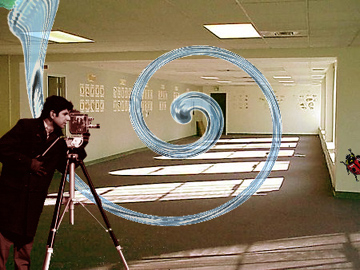
|
Visit the INI USA Northeast Kingdom website by clicking on the image left to see a multitude of new INI digital collages by Mark Fisher.
"Fame" by M. Fisher
March, 2003
*******************
"INI On Wheels," the cover illustration
by Maryclaire Wellinger for "Berenice",
An Italian Avant Garde Arts Journal
Edited by INISMO Founder, Gabriele-Aldo Bertozzi
Movember, 2002 Issue (Biannual)
| COVER ILLUSTRATION FOR "BERENICE", NOV 2002 |
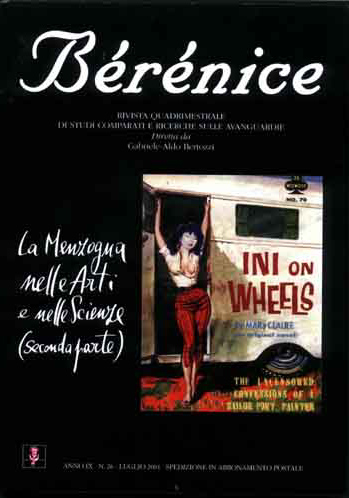
|
| INI Digital Collage by Maryclaire Wellinger |
M-C's Original Digital Collage,
"INI ON WHEELS", (below) was selected
as the cover illustration for the Italian
Avant Garde Comparative Literary Journal, "BERENICE" ,
its November 2002 issue. 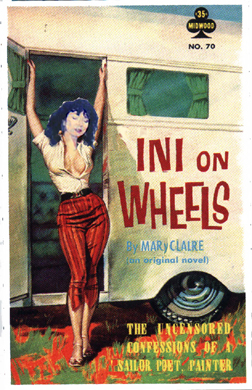
WHAT IS "INI"?
Italy's Newest Poetic Avant-Garde: Inismo by David W. Seaman, Ph.D.
Department of Foreign Languages
Georgia Southern University
Statesboro, GA 30460-8081
dwseaman@gsvms2.cc.gasou.edu
When one receives a letter or card from Gabriele-Aldo Bertozzi, the closing salutation is likely to include a phrase like "saluti ininterrotti", going out of the way to include a word with the succession of letters, I N I. This indicates the absorption of inismo in the mind of one of its founders. Inismo, ini, or I.N.I., comes from the terms, Internazionale Novatrice Infinitesimale, concepts that help define this avant-garde movement. As Angelo Merante points out in his essay, I domini operativi degli inisti,1 all three of these words suggest "extension", indicating the desire of inismo to go beyond the conventional. These terms invite some elucidation.
INI Recall -- Portrait of the New Governor Elect
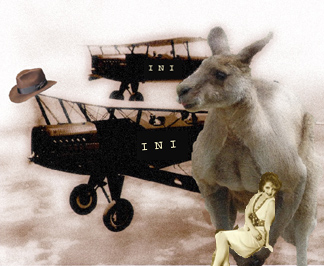
"I will sweep away the legislators in Sacramento" (Gov-Elect Arnold Schwarzeneghar)

My Strawberry Roan: An INI Folksong

Hurricane Isabel as Seen From Space: INI Astrophysics
Let's Go Surfin' Now . . . INI USA
INI Digital Collage M-C Wellinger April, 2003
***
I'd Rather Be Sailing M-C Wellinger july, 2003
Spring Comes to the Garden of INI
Apple Blossom Time
Summer Holiday

The Fishing Party
Sea at Sunrise #1
Sea at Sunrise #2
Charlie Yardbird Parker Blows Bleeding Hearts
Portrait of the Inist: M-C, New York City
by Mark Fisher November, 2001
INI Terror Attack Kit, Terror Code Bright Orange:
A Series in Five Panels March, 2003
INI Terror Attack Kit, Panel #1
from the kitchen of Michelle and Tom Ridge
List of Items, March 2003
Iniville, Pennsylvania INI Terror Attack Kit, Panel #2
from the kitchen of Michelle & Tom Ridge, Iniville, Pennsylvania
March, 2003
INI Terror Attack Kit, Panel #3
From the Kitchen of Michelle and Tom Ridge,
Iniville, Pennsylvania, March, 2003 INI Terror Attack Kit, Panel #4
Apron from the Kitchen of Michelle and Tom Ridge
Iniville, Pennsylvania March, 2003
INI Terror Attack Kit, Panel #5
Diamond Studded Cross from the Private Collection
Of Michelle Ridge, Iniville Pennsylvania, March 2003
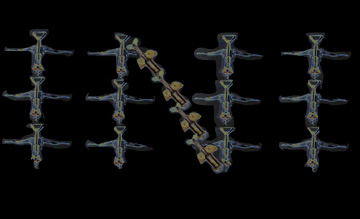
Internazionale is obvious, and it refers not only to the goal of expansion, but also to the implantation of inismo in Spain, Argentina, and the United States.
Novatrice is a Latinized version of "innovatrice", and I suspect that this term was influenced by the French lettristes, who use it.
Infinitesimale is also a term the lettristes have promoted; for them and the inisti it is not to be confused with our English concept of infinitesimally tiny, but rather it means leading to an infinity that is unknown and difficult to imagine. One can readily see, therefore, what the role of the avant-garde poet is: to lead the reader toward discovery of that vision beyond the finite world.
"INI Drivers' Handbook, State of INI"
an INI Digital Collage by Maryclaire Wellinger
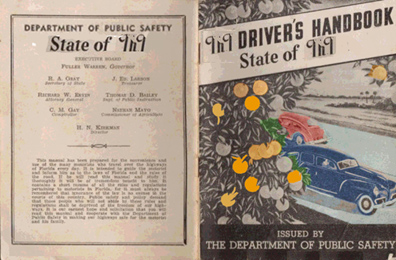
Inismo was initiated in Paris, early in 1980, by Bertozzi and Laura Aga-Rossi, and they were soon joined by Giulio Tamburrini, Angelo Merante, Moreno Marchi, and Antonino Russo. The first manifesto, Qu'est-ce que l'I.N.I. - Che cos'è l'I.N.I. was published in Paris and Rome in September of 1982, and the first exhibition of ini works was the same month in Paris, at the Salon de la Lettre et du Signe. This salon is a lettriste show, which suggests the ini relationship to the French movement. In fact, the first manifesto will declare, "INI was foreseen by Futurism, by Dada, and announced by Lettrisme."
Changing a Flat Tire
INI Digital Collage by Maryclaire Wellinger "INI Blimp"
INI Digital Collage by Maryclaire Wellinger

"Skywriting: First Lady of the Skies"
an INI Digital Collage by Maryclaire Wellinger
"INI Kewpie Doll Sunset"
an INI Digital Collage by Maryclaire Wellinger
| INI KEWPIE DOLL SUNSET |
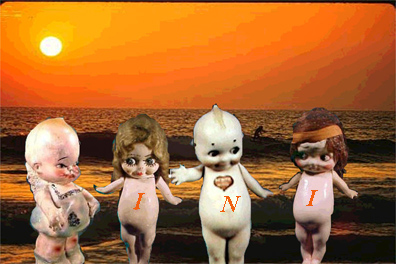
|
| an INI Digital collage by Maryclaire Wellinger |
The second manifesto, called Apollinaria Signa was created in the town of S. Apollinare, and alludes purposely to Guillaume Apollinaire, whose L'esprit nouveau et les poètes holds great importance for the inisti. Among the declarations in the second manifesto are calls for emancipation of the poet and the reader, and it lists the following among its formal advances:
Poetry is also scent and gesture
A sonnet can be hypergraphic and rhyme with a drawing...
A poet can use at his whim the pen or the brush, computer or mallet, tape or film...
Every word, even the oldest, will be heard for the first time.3
Poetry is not necessarily a written page
Poetry can also be seen or heard
"Shipwrecked on INI"
an INI Digital Collage by Maryclaire Wellinger
| SHIPWRECKED ON INI |
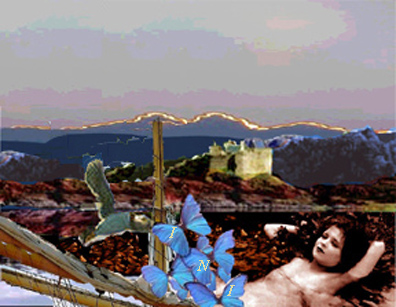
|
| INI DIGITAL COLLAGE BY MARYCLAIRE WELLINGER |
"INI Liftoff"
an INI Digital Collage by Maryclaire Wellinger
| INI Liftoff |
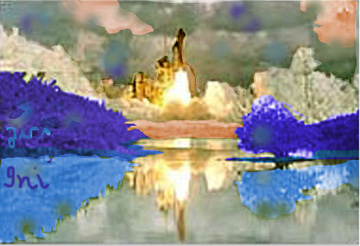
|
| INI Digital Collage by Maryclaire Wellinger |
| INI GEEK, INI ZEN |
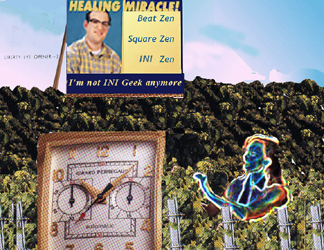
|
| INI DIGITAL COLLAGE IMAGE BY MARYCLAIRE WELLINGER |
an INI Digital Collage by M-C Wellinger
**********
"Last Chance"
an INI Digital Collage by Maryclaire Wellinger

INISA Flying Above a Solarized Lowell
an INI Digital Collage by Maryclaire Wellinger
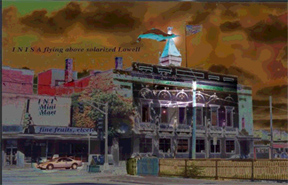
"INISA Swimming Through an LSD Molecule"
INI Digital Collage Image by M-C Wellinger
**********
"Butterfly Ballot"
INI Digital Collage by Maryclaire Wellinger
*****
"While She Sleeps"
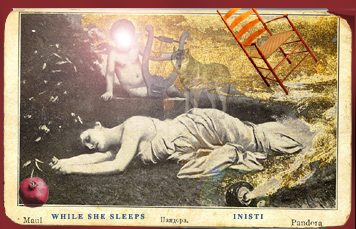
"While She Sleeps"
by M. Fisher
April, 2003
click on image left to go to M. Fisher's INIUSA website
Saint Emily in My Mirror April, 2003
INI Digital Collage M-C Wellingerr
"INI Songs to the Transcendentalists,
Emerson and Thoreau.
Song #1"
An Ini Digital Painting April, 2003
by Maryclaire Wellinger 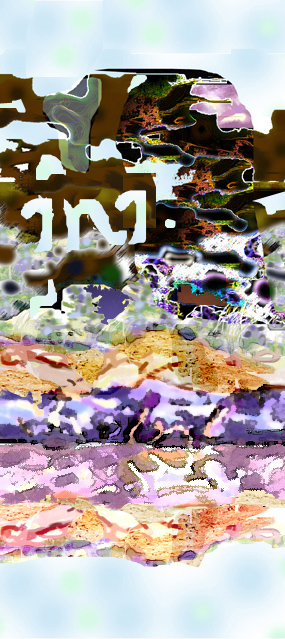
"INI Songs
to the Transcendentalists,
Emerson and Thoreau,
Song #2"
An Ini Digital Painting
April, 2003
by Maryclaire Wellinger
********
********
INI Art by the Founders of INISMO
Diluvio Universale Gabriele-Aldo Bertozzi
acrylic on canvas 1999
| Diluvio Universale 99 |
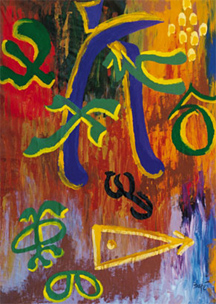
|
Ini sign for Suomi by Gabriele-Aldo Bertozzi
acrylic 2000
Arianna by Gabriele-Aldo Bertozzi
Fotografia Inista 1997
| Arianna 1997 |
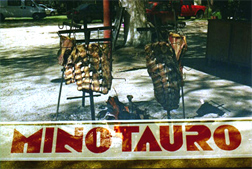
|
Moda Inista textile 1995 Argentina Oil & Acrylic 1994
Laura Aga-Rossi Laura Aga-Rossi
| Moda Inista 1995 |

|
| Argentina 1994 |
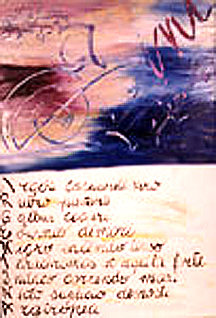
|
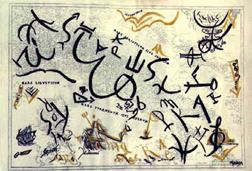
Italika
MARINISA BOVE
tempera su carta, cm. 50x68
2000
Two INI Images by FRANÇOIS PROÏA
******************************** 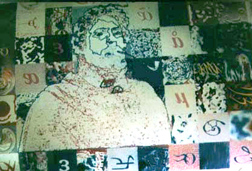
Le poète,
by FRANÇOIS PROÏA
1997
Inigrafia, cm. 30x45
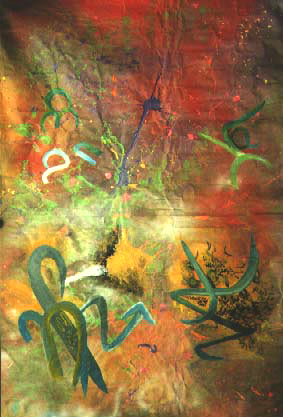
Escapades
by FRANÇOIS PROÏA,
acrilico su tela, cm. 200x150
1997
*************
Two Fotografia Inista by Angelo Merante
Paradigma della Visione 1999 Naissance des Phonemes 1997
| Paradigma Della Visione 1999 |
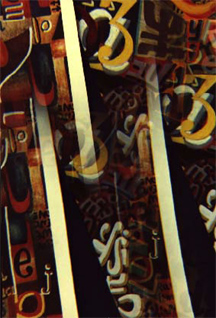
|
| photo INISTA |
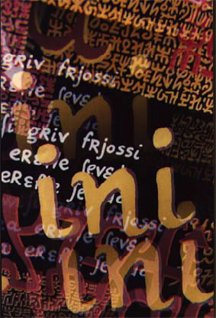
|
| Naissance des Phonemes 1997 |
|
 |
 Gabriele-Aldo Bertozzi's activities are concentrated in two fields. He is a professor of French language and literature as well as the founder of the International Innovatory Infinitesimal Movement, an avant-garde movement also known as Inism or ini). These two activities are merged in two journals of which he is both founder and editor; the C.U.S.M.A.R.C. (University Centre of Applied Multimedial Development for the Research and study of Creativity) and Bérénice (quarterly journal of comparative studies and research on the avant-garde).
After achieving a certain fame in the European Avant-garde circles in the 1970s, he founded Inism in 1980 (Paris, Café de Flore, 3 January). At the end of the 1970s and beginning of the 1980s authors such as Antonio Bueno, Primo Conti, Jean-Paul Curtay, Febo Delfi, Nino Palumbo and Philippe Soupault began to show an interest, both in Italy and abroad, in presenting, illustrating and translating some of his poems written in youth, but by this time he had definitely turned to abstract poetry; in his Neo-Greek edition of selected poems Ekloghí Piimáton (Athens, 1981), Demetris Armaos speaks of "Bertozzi's pre-history", "The Pre-history of INI". However, various anthologies have subsequently published his abstract poems, one of the most important being Mario Lunetta's Verso Roma /Roma in versi (Rome, 1986).
Bertozzi had been present as a character in several novels such as Un Uomo fuori del tempo by Lino Battista (traditional novel), Rimbaud en Abyssinie by Alain Borer (novel/essay) Jonas by Isidore Isou (hypergraphic novel), Città by Angelo Merante (innist novel) and Le Roman de Chieti by Roland Sabatier (object novel) before publishing his own first novel (an book object) Valenciennes (Paris-Florence, 1981) followed by Ci-annexé (Paris-Rome, 1983). He has also produced many poem objects. He appears as a character in the inist film San Remo by Pietro Ferrua and as main character in Bertozzi by Kiki Franceschi and in the recent Pour et contre Bertozzi by Isidore Isou (Portland, Avant-Garde Publishers, 1987) - a new Italian edition was published in 1991 and up-dated by Sandro Ricaldone for the "Opuscola" series (Sileno, Genoa). He has also been the inspiration for works by Laura Aga-Rossi, Albert Dupont, Maurice Lemaitre, Gaetano Marinò, Argentina Capriotti, Eugenio Giannì, Giovanni Agresti and Francois Proïa (the latter, apart from the well-known painting Una sola multitudini, has also dedicated to Bertozzi the recent film, INI soit qui mal y pense. De Rimbaud à Bertozzi). Important studies are being published on his work which is also the subject of various university theses.
In spite of the notable differences that exist between Inism and contemporary movements or groups, other international avant-garde figures have established close contacts with Bertozzi.
Bertozzi, who is a university professor and editor of the journal Bérénice (33 numbers in the first series and 6 in the new series), has been present at most of the inist exhibitions that have represented the main moments of expansion of this international movement in its substitution of experimental forms with unique and innovative aesthetic works. In 1991 he gave a course on Inism at the University of Paris XII - Val de Marne (France). In 1992 an important biannual poetry award was founded in Spain (Collado-Villalba - Madrid) bearing his name ("Premio Inista de Poesía "Gabrielle-Aldo Bertozzi""). October 1994 saw the second year of this ceremony.
Bertozzi has made important rediscoveries, among whom Lacenaire, Charles Cros, Nicolas Beauduin, but only a few of his most important studies will be remembered here: Saggio sull'avanguardia, Roma, Edizioni dell'Ateneo, coll. "Nuovi Saggi", 1989, Rimbaud. Vita amore e poesia da reinventare, Roma, Lucarini, coll. "Proposte", 1990 (essays) and La Signora Proteo, Padova, Piovan, 1990 (theatrical work in three acts now republished in Edizioni Scientifiche Italiane); Rimbaud. Le opere, i luoghi, Chieti, Métis, coll. "Init", 1991; Inismo Spagnolo e Argentino, Chieti, Solfanelli, coll. "Plaisance", 1992 (Anthology); Forward, translation and notes to Illuminazioni and Una Stagione all'inferno by A. Rimbaud both volumes published for the TEN series, Newton Compton Editori, the first in 1994 and the second in 1995. At the moment there is also in the press an introduction and translation for "Oscar" Mondadori of A. Rimbaud's Viaggio nell'Harrar e nell'Ogladine. He is also preparing a volume entitled Dall'alchemia al multimediale. Saggio sull'Inismo.
He has been head of the Literature and Languages Department at the "G. d'Annunzio" University (1993-1997).
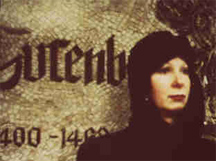 Laura Aga-Rossi is one of the founders of Inism and has taken part in all the most important national and international exhibitions. She edited the edition of Qu'est-ce que l'Internationale Novatrice Infinitésimale (Paris-Florence, CICK-Téchne, 1981) as well as Sekondo Kwaderno INI (Rome, Nove Editrice, 1984. She is one of the cosignatories of the Second Ini Manifesto, Apollinaria Signa, (Sant' Apollinare, 1987) as well as of the Third Ini Manifesto, Videoinipoesia, (Rome, 17 June 1990) and author of The Clemente Padín's case. Protomanifesto. What Inism is NOT! (1996).
A french scholar and writer, she is the first person to have translated Picabia's Dadà poems, as well as the Opere complete of Charles Cros and Lacenaire's Memorie di un poeta assassino in to Italian. Her translation of Apollinaire's Peintres Cubistes is includes a most bold choice of calliogrammes, or ideogrammes, translated for the first time into Italian in their original form. She has also translated the first edition of Verlaine's Poètes maudits , which also contains an introduction by Gabriele-Aldo Bertozzi. She is editor of Bérénice, quarterly journal of comparative studies and research on the avant-garde, in which she has contributed several studies on the "poètes maudits", Impulsionism, Integralism, Avant-gardism and Inism. Her choice of authors and themes is indicative of the coherence of her studies. As she herself affirms she spent an initial preperatory period in cultivating her artistic sensitivity, a sensitivity characterised by a latent spirit of rebellion which was to be substituted by an active and conscious involvement in the movement in its pioneering years (1980-1987) and a full awareness of its importance as an aesthetic revolution and the expression and means to operate within it which is characteristic of the subsequent phase of Inism's expansion. Her works are most varied "I usually use oils for their sense of thickness and light, in which each brushstroke is a sign, for the aggressiveness and depth it allows in graffiti and superimpositions, fusions and separations, and also allows me to work monocromatically giving form to colours. But I also use inks which are so light and changeable, and which produce surprising effects of "hasard objectif" and flights into space. Collage on the other hand is more concrete even if I have always used it for transparant effects. These are only a few examples because I also use anvils, quills, hammers, computers, compressors, pencils, exposable film and anything else that allows me to express myself". These works consist of canvasses, art books (the 1992 "Omaggio a ...." series of 70x60 cm may be mentioned here), novels (Autobiografia, for example written in 1989 which is an example of descriptive Inism) an inist book of travels (Trittico odeporico - Bérenice, II, 4 marzo 1994), postal art (Lettere agli Inisti, 1992, for example) and inist poetry and critical and theoretical essays. She also ran a series of courses for primary school teachers in Pescara that took place on 14-15 December 1994 and 25,26,27 January 1995, entitled "INIb(a)m(a)bINI. Incontro con l'Infanzia" of which the acts are about to be published.
Apart from her very personal and critically lucid approach, Aga-Rossi has also made an important contribution in creating inist clothing; there are models in leather, wool, silk, embroidery, some of which have designs and some of which have been branded, all of them being her very own creations. François Proïa, one of the most active interpreters of Inism in the last few years, only became an actual member in 1988, and since then his enthusiastic, generous and inexhaustible contribution to the movement's development has been most precious. It is he in fact who prepared all the catalogues and posters concerning the exhibitions after he entered the movement. However, his initial interest can be seen in the fact that he had already been connected with the inist group since 1985. In fact, the quartly Bérénice, edited by Gabriele -Aldo Bertozzi, in which he contributed articles on the relationship between the cinema and literature, included him among its collaborators as expert in avant-garde cinema.
A researcher in French language and literature at the "G. d'Annunzio" University in Pescara, he has published a book of comparative literature Di qua e di là dall'immagine. Letteratura e cinema nelle avanguardie francesi del Primo Novecento, Chieti, Solfanelli, 1992 and has become a part of the editing staff of Bérénice. As Bertozzi has affirmed, "from his writing emerges those reference points and preferences that characterise his development in the French avant-garde scene and in which is revealed a particular predilection for Desnos and Surrealism, which, in his turning from research to creativity prefigured his entrance into the INI movement with unexpectedly original results. In 1988 he made the film entitled ini 96S and in June of the same year took part with other inists in the Salon Comparaison at the Grand Palais in Paris"5. He is the co-signatory of the manifesto Videoinipoesia (Rome, 17 June 1990) and the producer of the first videoinipoesia Telefonata a Rimbaud (Sant'Apollinare 16 September 1990) presented in Paris during the course on Inism held by G-A. Bertozzi at the University of Paris XII- Val de Marne (January 1991). It is with him that the multimedial forms and inist cinema took a definite turning point. We may recall here his film De Rimbaud a Bertozzi, Ini soit qui mal y pense. He is also an active member of C.U.S.M.A.R.C. (University Centre of Applied Multimedial Development for the Research and study of Creativity). During the International avant-garde Conference "Di quà e di là dalla parola. La Lettera e il Segno nelle "Scritture" Contemporanee" he read a paper entitled L'Inisme et les mondes virtuels, which was later published in Bérénice, (March 1993). His creativity and professionalism are most apparent also in his odeporic works Au pays des poétes maudits 6 and Essence absolues, published in Bérénice, II 5 (July 1994). He took part in "INIb(a)m(a)bINI. Incontro con l'infanzia" courses7 with his contribution Il mondo delle immagini. Starting from the computerised graphic elaboration of a single image he has indicated a way of making films as part of a creative inist project applicable to children's forms of expression with the aid of videoclips and films already made within the inist circle. He is president of the ASSO Cultural Association (Arte Scienza e Senso Olistico) which has two journals, "Lintsella" devoted to Inism and "Arcipelago" devoted to critical studies.
|  |
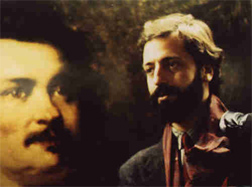
Has been a member of Inism since its foundation (1980), taking an active part both on a creative/productive level as well as on a theoretical one in promoting on an international scale the ideas contained in the first Inist manifesto. He has taken part in all the activities the movement has organised or promoted as well as organising and running two inist exhibitions himself which took place in January 1985 at the University of Poitiers (France). He is the cosignatory of the second Ini manifesto Apollinaria Signa (Sant'Apollinaire - Perugia, 1987) as well as of the manifesto La Videoinipoesia. Manifesto Inista (Rome - Sant'Apollinaire, 1990).
As a convinced promotor, like all inists, of the need to abolish every boundary that exists between the operative sectors in art and constantly preoccupied in reaching and stimulating all the senses of the spectator through a superimposition of levels of expression to be perceived simultaneously, he composes and recomposes original calligraphic patterns, placing side by side scriptural elements with everyday objects, which become for him "other words" of a unique and free language and a new aesthetic. He also works with verbal sounds deliberately deprived of any trace of meaning, transcribed on paper, painted on canvass or transferred onto unusual and original stands. Merante stands out both for his optical anagrammes and for his "inika sonorika" of which the theoretical text, read at the international conference of avan-garde art "Di qua e di là dalla parola. La Lettera e il Segno nelle "scritture" contemporanee", was published in the first number of Bérénice, quarterly journal of comparative studies and research on avant-garde literature and art (March 1993) a theme he was to take up again in Introduzione all'inika sonorika. Verso le nuove forme sonore nell'idea inista (Bérénice, II, 5 July 1994).
In its simplest form an optical anagramme is a series of letters laid out on a sheet of paper. These letters (which include the alphabets of languages of the present and the past as well as invented alphabets) are scientifically, or rather, skillfully jumbled, sometimes also with illustrations, so as to clearly present, through their being perceived simultaneously by the eye (hence the name of this artistic form), at least two textual interpretations. Thus the optical anagramme, by using a wider range of supports or technical solutions, naturally embraces poetry/painting on various levels and, like every abstract form, is a means of reaching a universal language. Abstract poetry - in the sense of it being a free orchestration of voices, noises, natural sounds or electronically synthesised, unknown words, written in the symbols of the International Phonetic Association - becomes Inika Sonorika, often recorded on a magnetic tape. Two of his compositions, Ompokema pt.2 and Fonitiko leSinjo, have been broadcast on Radio Nacional España - Radio 2, during the second and third Festival Internacional de Radio Art - F.I.R.A. 90 and F.I.R.A. 91. He is also the author of infinitesimal novels (Città. Introduzione a un nuovo concetto di romanzo, Rome, Nova Editrice, 1984 and the inist edoporic story Verso il verso, ma in direzione opposta, in Bérénice, II, 4 March 1994, may be mentioned here) as well as of numerous book objects and art books
Marinisa Bove (France). Née en France, près de Saint-Etienne, elle enseigne le français à l'Université "G. d'Annunzio" de Pescara. Sa rencontre à Pescara en 1989, avec Gabriele-Aldo Bertozzi, titulaire d'une chaire de langue et littérature françaises, est décisive. En effet, sa curisosité et son intérêt pour l'art et les avant-gardes l'amènent à suivre avec assiduité, pendant quelques années, les manifestations inistes, avant de devenir un membre actif de l'Inisme en juin 1993. Au sein de l'Inisme, elle trouve une réponse qui satisfait pleinement sa soif de nouveau et elle participe dès lors aux manifestations les plus importantes du mouvement. L'esprit révolutionnaire régnant dans le groupe des Inistes romains et de Pescara la pousse à emprunter la voie de la créativité. Fascinée par l'ouverture esthétique qui caractérise ce mouvement, indissolublement liée à l'éthique, elle compose des poèmes graphiques où les signes de l'ordinateur se mêlent au collage, à la gouache, au fusain, à la peinture à l'huile, dans une explosion hypergraphique. Antonino Russo écrit à son sujet, dans l'article Il messaggio è nell'aria, paru dans le journal Napolinotte du 6-12 juillet 1995: "Il segno ipergrafico per Marinisa Bove è l'artefice della sua scrittura-pittura che va interpretata unicamente in chiave estetica. Non vi è alcunché da leggere, dal momento che il messaggio è nell'aria: bisogna captarlo con le antenne che ogni fruitore avvertito possiede". Son goût pour l'écriture combinatoire la porte à se pencher sur la poétique d'Italo Calvino au sein de l'Oulipo, auquel elle rend hommage avec des compositions graphiques inistes (Les Villes inivisibles, 1995 et Bérénice, 1995) et un article paru dans la revue Merope, V, n° 8, janvier 1993 (Italo Calvino à Paris: Il Castello dei destini incrociati ou la combinatoire iconographique). Elle publie dans Bérénice, II, n° 4, mars 1994, un poème iniste, Homo viator, sur le thème du voyage. Rolando D'Alonzo, dans sa page intitulée Benzine, consacrée aux avant-gardes et à la littérature, parue dans le mensuel Rossoenero, II, n° 5, 1995, écrit un article sur l'Inisme, accompagné d'une de ses uvres (Spirale, 1995).
En outre, le domaine de la traduction lui offre également un terrain fertile pour exprimer sa sensibilité créative: elle traduit de l'italien la pièce de théâtre de Gabriele-Aldo Bertozzi, La Signora Proteo et la pièce Gradiva. Colei che avanza, de Laura Aga-Rossi (à paraître) ainsi que de nombreux articles consacrés à l'Inisme et aux inistes. Elle coordonne les traductions des catalogues illustrant les expositions du mouvement (L'idea di "visionario", 1995 et Oltremare Oceano. Le Amerike, 1998) |
 |
|
|
 |
|
|
|
|
|
|  |
